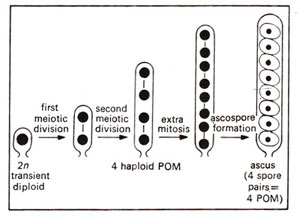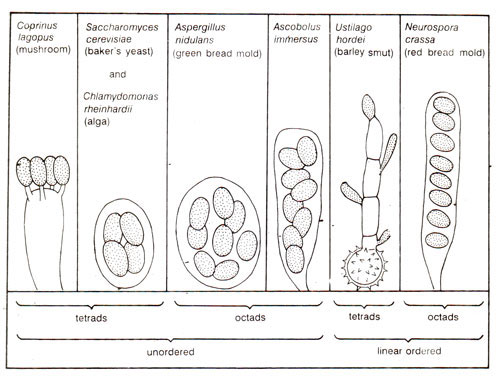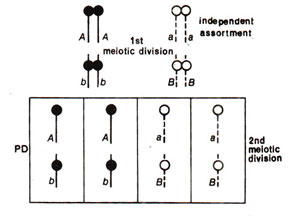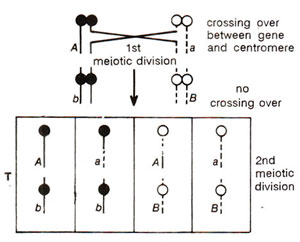
Fig. 11.1. Production of paired tetrad in an ascus, due to linear meiosis and subsequent mitosis (POM = products of meiosis).
As mentioned above, in some algae and fungi, the products of a single meiosis can be recovered and examined. The products of a single meiosis may consist of four or eight spores, retained in a sac like structure, and are described as a
tetrad. Whenever, the products of meiosis consist of eight spores, they result from four meiotic products undergoing a further mitotic division. These groups of eight may be called
octads, but for convenience they are also called
tetrads, because they represent paired tetrads (Fig. 11.1).
The spores derived from meiotic division, whether four or eight, may be enclosed in two different ways. In some species, like
Neurospora (also
Ustilago) the spores are arranged in a linear order and are described as
linear or
ordered tetrads. In these cases the consequences of first and second meiotic division can be inferred from this linear order. In other cases, however, the spores are mixed and do not retain the order, so that they are unable to suggest the consequences of first and second meiotic divisions. These are described as
unordered tetrads.

Fig. 11.1. Production of paired tetrad in an ascus, due to linear meiosis and subsequent mitosis (POM = products of meiosis).
A variety of ordered and unordered tetrads are shown in Figure 11.2. It will be seen later in this section, that the ordered tetrads can be used to map the centromere on linkage map, a facility not possible with unordered tetrads. The mapping of centromere, facilitated by ordered tetrads, is particularly useful because in algae and fungi, where chromosomes are very small, cytological identification of centromere is difficult.
The technique of using each of the individual spores of a tetrad for analysis to derive information on linkage and recombination is described as
tetrad analysis. Each spore can be separately cultured and its phenotype can be studied to derive information regarding its genotype. For instance, if
A and
B are two genes located on different chromosomes, they will undergo independent assortment. The zygote
AaBb derived from parents
Ab and
aB can give rise to
2Ab : 2aB or 2
AB : 1
ab segregation. When the products of meiosis are of only two types, these would be
parental ditype (PD)or
non-parental ditype (NPD) depending upon whether or not they resemble parents. These parental ditype and the non-parental ditype result due to independent assortment (Figs. 11.3, 11.4). On the other hand, the four products of meiojsis from
AaBb may also be obtained in a ratio 1
AB : 1
Ab : 1
aB : 1
ab thus giving rise to tetratype tetrads, which will result due to crossing over between the centromere and one of the two genes in question (Fig. 11.5).

Fig. 11.2. Various forms of tetrads and octads; (a) unordered, (b) linear ordered.

Fig. 11.3. Production of tetrads classified as parental ditype (PD) during meiosis in a dihybrid, due to independent assortment of two genes located on different chromosomes. (Chromosomes of one parent are shown with solid centromeres and solid lines; those of the other parent shown by empty centromeres and broken lines)

Fig. 11.4. Production of tetrads classified as non-parental ditype (NPD) during meiosis in a dihybrid, due to independent assortment of two genes located on different chromosomes. (Chromosomes of two parents as in Fig. 11.3).

Fig. 11.5. Production of tetrads classified as tetratype (T) during meiosis in a dihybrid, due to independent assortment of two genes located on different chromosomes. (Chromosomes of two parents as in Figure .11.3)










